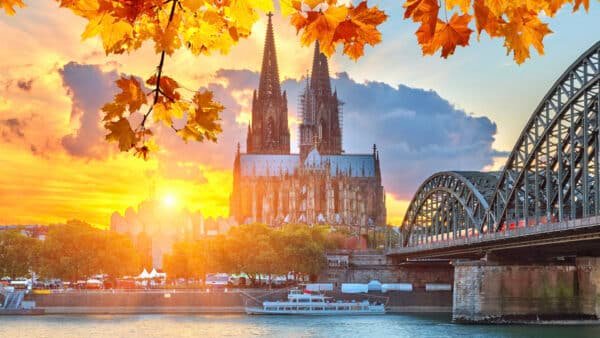Contrary to what summer’s high-season tourist numbers might suggest, autumn is arguably the best time for your next European vacation. From September through November, many European cities offer the sweet spot between atmosphere and accessibility — the weather is still warm, the calendar is packed with local events, and prices dip just enough to feel like you’ve beaten the system.
Here are a few more reasons to postpone that summer trip, and plan next year’s European getaway for the fall instead:
The Cities Come Back to Life

Particularly in southern Europe, many locals flee the heat of the city centers and escape to the countryside or the coast for part of the summer. The result? You get crowds of fellow travelers, but none of the authentic, local energy that makes many European cities so magnetic in the first place.
By the time autumn arrives, the balance shifts. Residents return as the tourist wave fades, and cities return to their natural state. The atmosphere feels livelier, and you’ll have a chance to experience daily life as it’s actually lived. September also kicks off many local events in the big cities — film screenings, music festivals, street fairs and local parades that were mostly on hiatus all summer begin to fill the calendar again. If you really want to see what city life is all about, wait until autumn when you can experience it among the locals.
Go When the Weather Works in Your Favor

Autumn doesn’t mean giving up on beaches or outdoor activities. In much of Europe — especially along the Mediterranean — warm, sunny days stretch well into October and even November, but without the oppressive extremes of peak summer. You’ll still have long afternoons for café terraces and strolls along the beach, but with cooler evenings that make wandering city streets or lingering over an al fresco dinner much more pleasant.
Once fall arrives, the occasional rain is a welcome change, signaling the end of wildfire season and the easing of drought conditions. In northern Europe, you’ll get crisp mornings, late sunsets, and foliage that can make a basic train ride unforgettable. You can hike without risk of heat stroke, and enjoy the beaches, rivers and lakes without fighting for a spot to swim. The weather won’t limit your trip in autumn — in fact, quite the opposite. Cooler temperatures will provide more flexibility, as your days won’t be ruined by heat waves or dictated by the need to plan everything around midday shade.
Easier Logistics

In high season, almost everything requires advance planning: trains sell out, restaurants are booked weeks in advance, and the only rental cars left are either manual or triple the normal price. By autumn, those headaches ease. You can usually snag a same-day ticket for most trains or ferries, walk into a restaurant without a two-hour wait, and find accommodations or transport without scouring five different websites.
Even flights to, from, and within Europe are often cheaper and easier to book during shoulder season. That kind of flexibility not only makes travel less stressful, but it opens the door to more spontaneity. If you hear about a festival in a nearby town or decide to add a day trip to the mountains, you can actually go without worrying about impossible logistics getting in the way.
The Best Views Come in the Fall

While a 1am sunset in Stockholm is certainly something worth experiencing, fall brings a more normal daily routine. Earlier sunsets also mean you can experience landmarks ideal for nighttime — such as the Eiffel Tower light show or Budapest’s Parliament lit up over the Danube — without staying awake half the night. And for both amateur and professional photographers, the combination of autumn leaves and softer lighting means it will be easier to capture photos without harsh shadows or melting under the midday sun.
Outside of the cities, Europe’s nature is also at its peak. Hiking trails in the Alps or Scottish Highlands are quieter, and vineyards in the Douro Valley and Tuscany are right in the middle of harvest season. Many national parks that require advance reservations in summer open up, and thermal baths in places like Hungary or Iceland become even more enjoyable once the air cools down a bit.
Eat With the Season

If you consider yourself a foodie even just a little bit, fall is your season to be in Europe. Local markets are overflowing with just-harvested grapes, apples, and figs, and restaurants begin to lean into dishes better suited for cooler nights — stews, roasts, and seasonal vegetables that rarely make the summer menu.
Different regions have their own fall specialties. In Italy and France, it’s truffle and mushroom season. In Spain, olive and wine harvest festivals fill the calendar. Germany and Austria lean into hearty classic comfort foods, and in Scandinavia, tasty cod and herring dishes show up on menus across the region. Waiting until fall simply means eating alongside the local calendar, not off the tourist menu.
Final Thoughts:

Compared to July or August, spending the autumn in Europe can be a much more enjoyable experience. Tourist crowds will have thinned out, the heat will finally cut you a break, and most flights and hotels will return to their non-peak-season prices. So as most visitors flock to Europe in the summer, you’ll be strolling through plazas, museums, and markets with a little more breathing room. Autumn allows you to experience Europe without the stress, and once you’ve done it once, you just might never plan a summer trip again.
Emily is a freelance writer who has been traveling full-time for over five years She has visited dozens of countries but can often be found in Spain and Mexico. In her Substack, Extracurricular Pursuits, she shares personal essays and travel stories that document the quirks, chaos and realities of living abroad.

